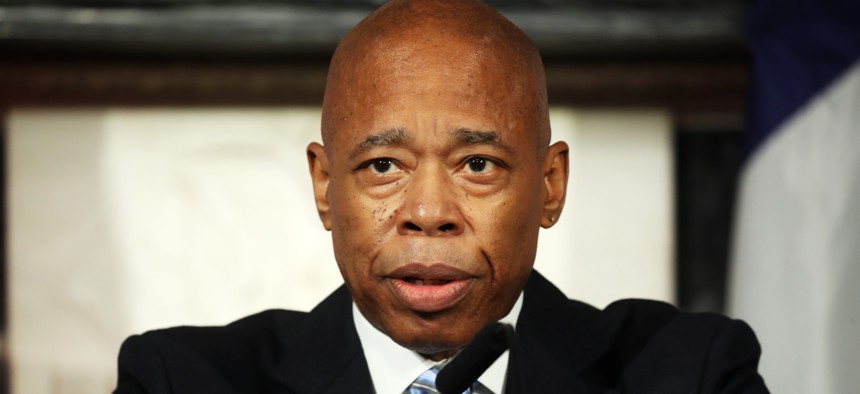Budget
Adams announces $109 billion preliminary budget, addresses $7.1 billion budget gap
The New York City mayor said he was able to balance the spending plan and restore several unpopular cuts to police, fire, sanitation, and parks, attributed to benefits from reduced spending on asylum-seekers, city reserves and higher-than-expected tax revenue.

New York City Mayor Eric Adams Spencer Platt/Getty Images
Mayor Eric Adams unveiled a $109.4 billion preliminary budget for New York City, balancing a projected $7.1 billion budget gap by reducing spending on asylum-seeker services and using city reserves on top of higher-than-expected tax revenue. The budget spares the Police, Fire and Sanitation departments from a round of cuts announced in his November financial plan, the mayor said, in order “to protect public safety and cleanliness.” The Departments of Education, Social Services, Youth and Community Development, and the Department for the Aging also had their savings plans adjusted to ensure services continue.
“We closed the fiscal year 25 budget gap without additional federal aid, or raising taxes,” Adams said when he announced the preliminary budget plan at City Hall Tuesday afternoon.
The announcement kicks off months of negotiations with the City Council, many of whose members, including Speaker Adrienne Adams, have vowed to fight agency cuts. The budget goes into effect in July.
On Tuesday, Mayor Adams said the city was able to close the gap while restoring cuts thanks to savings on services for asylum-seekers that are, in part, to a reduction in the expected rate of new arrivals to the city in 2025. Efficiencies in staffing and service-provision at the numerous Humanitarian Emergency Response and Relief Centers serving new arrivals led to roughly $1.7 billion in savings over fiscal years 2024 and 2025.
The city’s tax revenues also benefited from a stronger economy than previously forecasted – by $1.3 billion in fiscal year 2024 and $1.6 billion in fiscal year 2025 – but the mayor warned of a potential downturn in the future. The preliminary budget projects out-year gaps of $5.2 billion, $5.1 billion, and $6 billion in fiscal years 2026 through 2028. And while warning of dire straits to come, Adams touted a record-level $8.2 billion in reserve in the city’s Rainy Day Fund.
The mayor’s budget announcement came hours after Gov. Kathy Hochul released a $233 billion executive state budget. The governor’s plan includes a number of elements Adams has been pushing for, including $2.4 billion to address the explosion of migrants seeking services and a four-year extension of mayoral control of city schools, which is set to expire.
“While we still need to review the details of the governor’s executive budget that was just released, if we receive sufficient funding from the state we will be able to cancel the April [Program to Eliminate the Gap] savings program and avoid the possibility of service reductions in the future,” Adams said on Tuesday.
In September, the mayor warned that without state and federal aid to support immigrant services, the city would see cuts in future budget proposals in November, January and April. In his November financial plan, Adams called for 5% cuts to city agencies through a Program to Eliminate the Gap, also known as a PEG. Last week, Adams reversed a number of those, including cancelling a Police Academy class and cuts to community school funding. He also said the city’s public library systems would not face additional cuts that could have threatened Saturday service, after Sunday service had been chopped.
The new plan appeared to attempt to address some of the most unpopular cuts while shoring up areas, like housing and homelessness, that have garnered criticism for the mayor. The plan addresses a $900 million shortfall in cash and rental assistance through the voucher program known as City PHEPS.
While police, fire, and sanitation services were spared entirely from the PEG in the January plan, most other agencies met or came close to the 5% savings target. The city’s public library systems were also exempted from further service reductions, but previous cuts – including to Sunday services – remain in place. Other agencies, like the Department of Education, Social Services, Youth and Community Development, and the Department for the Aging, avoided some potential cuts, while still seeking savings.
“After reviewing agency submissions, we determined that some agencies could only meet their targets by significantly disrupting service,” Adams said.
The preliminary budget includes longer-term funding for a number of education programs that had previously been paid for on an annual basis, in order to avoid fiscal cliffs, Adams said. That includes funding for charter school costs and school transportation. The preliminary budget also has the city covering the Department of Education’s $80 million share of the Summer Rising, a youth enrichment program operated jointly with the Department of Youth and Community Development. The DOE’s portion of the program had previously been funded through temporary federal stimulus dollars.

